Cookies help us deliver our services. By using our services, you agree to our use of cookies.
EID Trials
As early as 1992 Shearwell Data Ltd began participating in electronic ID trials around the country. These trials involved not only different devices, but also different species. As a result of involvement in these and many other trials, the company has expanded its knowledge of what works best. Hands-on experience in day-to-day, on-farm operation of our systems not only ensures that Shearwell solutions are fully tried and tested but also that they undergo continuous development.
Below are some of the trials and projects we have been involved in:
- South West Sheep Management Group trial [1996-2001]
- Exmoor Beef Producer Group trial [1998-2001]
- Torridge LEADER trial [1998-2001]
- Knighton Market Project [1997-2001]
- Fair5th Project [2002-2005]
- Southwest Livestock Project
as well as many more.
South West Sheep Management Group Trial
Six farms using implanted transponders, ruminal bolus and a range of readers and recording equipment. Over 50,000 sheep were identified during the trial.
The South West Sheep Management Group (SWSMG) was set up in 1996 to explore Electronic Identification (EID) in sheep. The five farms who joined the SWSMG represented a cross section of pedigree, hill, marginal and LFA (Less Favoured Area) farms. The trial was formed to evaluate the use of EID and also to set parameters that would allow such research to be of help for the UK to use when comparing with the IDEA trials into electronic identification that were taking place in Europe.
The aims of the project were:
- To identify the areas of need for improvement within the individual sheep farm
- To improve performance through recording
- To identify the productive and non-productive animal
- To improve the economic performance of the sheep
- To monitor animal health trends
- To improve the gross margin per hectare on members' holdings
- To employ additional full time persons as a result of the project
- To enable the farmers, their customers, the slaughterhouses, the processors and their retail customers to achieve total traceability from birth to slaughter and beyond
- To Scrapie genotype stock rams with a view to elimination of scrapie from members' flocks
- To use microchips as it would not be viable to record commercial flocks by way of visual ear tags. Chips allow automatic accurate data capture, whereas visual tags take longer to read and are impractical where tasks have to be performed in adverse weather conditions
- To record electronically avoiding transcription errors
- To evaluate the success and value of different feeds with varying percentages of protein in cake and to assess the performance of other feeds.
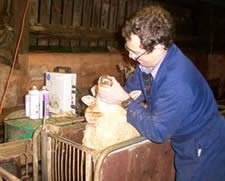
Equipment used
- FDX B Implant transponders
- Handheld readers
- Ruminal Bolus (from 1998)
- Static readers (from 1998)
- FarmWorks Classic - Farm Management Software
- Handheld Shearwell Stock Recorders - to capture livestock data sent from a reader or inputted manually
Exmoor Quality Beef Producer Group (EQBPG) Trial
The EQBPG was established in 1998 and was funded through Exmoor LEADER. The project had the following aims:
- To establish a two year electronic identification trial using bolus in cattle - over 3000 bolus used
- To establish monitoring and evaluation procedures to provide information for the trial and participating farmers on breeding, finishing and traceability
- To establish computerised records for cattle
- To raise awareness of traceability, information management and Electronic ID across Exmoor
- To automate recording in the hopes of reducing labour costs and transcription errors
- To improve stock quality through increased recording and analysis of data
- To ascertain whether it was feasible and practical to expect abattoirs to retrieve bolus and return them to Shearwell Data Limited
There were two phases to the project. Phase I had seven farmer members, encompassing 2,784 ha of Exmoor. 1,486 beef cows and their followers were administered with ruminal bolus in year one. A further five members were recruited for Phase II.
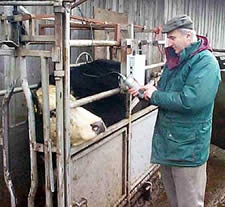
The key component of the trail was the HDX ruminal bolus. In parallel with the RF device in the animal, the equipment and software for the collection and storage of the data also formed part of the trial. This comprised:
- The Shearwell Stock Recorder Handheld Computer - with software developed by Shearwell Data Ltd (SDL), to capture and identify cattle when used in conjunction with a reader
- FarmWorks Classic - SDL’s livestock management program which collates data either entered manually or streamed from the Shearwell Stock Recorder.
- Radio Frequency Readers - Handheld readers or race readers were linked to the stock recorder by an RS232 cable. Where the cattle were identified with a ruminal bolus, the most effective location for the race antenna was on the left hand side of the crush and on a non-metallic mounting.
The main use of the EID systems was when handling cattle for weighing or routine treatment. A further time saving became apparent on those farms under restriction due to Bovine Tuberculosis. The requirement for repeated handling for testing was made less onerous by the ease of identification of cattle as they entered the crush. A time trial established an improvement in recording time of over 100% compared to manual handling and recording. Software was written to transfer data to the SVS with TB test details.
A noticeable, but as yet unquantifiable, reduction in stress on the animals was noted as the operator did not have to ascertain identity from the ear tag.
The enhancement in apparent welfare of the animal and the reduction in the labour required for routine handling procedures are some of the positive benefits of the trial.
Torridge LEADER Trial
Devices and Equipment Used
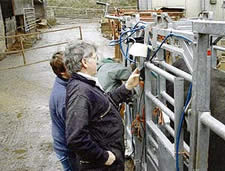
- Readers - Both handheld reader and a race reader were trialled
- Ruminal Bolus and electronic ear tags were trialled
- A Handheld Stock Recorder was used for automatic data capture and/or manual input. This was linked to a reader and an electronic weigh head for accurate data collection.
- TruTest load bars and weigh heads were used and stock weighed for varying reasons:
- Dairy farmers weighed the heifers to ascertain when heifers had reached the correct weight to be serviced
- Beef farmers weighed all stock to calculate weight gain - especially cattle due to go into the food chain
- Sheep were weighed to not only ascertain weight gain, but also to weigh prior to selling for slaughter.
Software
1. FarmWorks Classic Software - Software written By Shearwell Data Ltd was used and data collected on the Handheld Stock Recorder was uploaded to the program for greater analysis. Although the program did not cater for dairy needs, all farmers were able to analyse weight gain. Beef Members were able to use the program to assist their record keeping with regard to statutory requirements. Members could use the program as an aid to management.
2. Handheld Software - members used the Stock Recorder to record treatments, weights, calvings / lambings and TB Testing. The software also allowed comments to recorded against individual animals and parentage to be viewed.
Retention Rates
Ear tags were chosen by some as they were visible, because they could be the secondary tag and because some members already had an out-of-parlour EID system in place.
The bolus was chosen as it was deemed to be more fraud proof and could be re-cycled.
One of the conclusions of the trial was 'The retention rates for the bolus device showed a significant improvement on the eartags, with no bolus being lost'.
Knighton Market Project
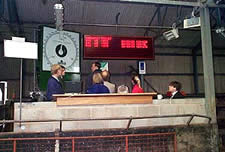
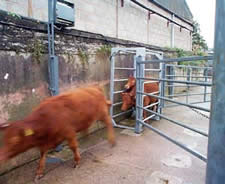
The second phase of the trial involved five farms which bolused all their cattle and used FarmWorks Classic as a management aid. The program allowed data to be sent from the farm PC to the market software via the web. When the animals passed the reader at the market and entered the ring, information on each animal was displayed on a visual display screen. All were supplied with handheld and static readers together with Stock Recorder Pros to capture the data.
Fair5th Project
EID and DNA Tracing
Shearwell Data was involved in a three year European Commission Research Project to develop a double system based on electronic identification (EID) and DNA profiling for tracing animals and meat.
The aim of the project was to improve traceability of livestock and meat in practical EU conditions. This research and development project involved ten partners from five countries and was divided into two phases (research and implementation) and structured in three parts (electronic identification, DNA fingerprinting and validation of the system).
Other partners in this project included the University of Barcelona, the Joint Research Centre at the European Commission, German, French, Italian and Spanish Research Institutes and the Irish genetic testing company Identigen.
Shearwell Data ran all of the UK trials. The aims of the project were to DNA sample and insert boluses in 1,000 sheep and 3,000 cattle and DNA sampling and inserting transponders in 1,000 pigs. However concerns in the abattoir over food safety with injectables in pigs prevented this quantity of pigs being recorded. Only 50 were injected and recorded through the system. Delays in the arrival of retrieval and reading equipment in the abattoir meant that not all cattle were recorded from birth through to carcass.
Equipment used
- Ruminal Bolus - sheep and cattle
- Implants - pigs
- Handheld readers
- Static readers
- FarmWorks Classic
- Shearwell Stock Recorder
- Static reader in the abattoir
- High frequency reader in the abattoir
- High frequency labels in the abattoir
- DNA sample labels
- IPAQ handheld to read HF label and write to a label on the DNA sample
The Southwest Livestock Project
The South West Livestock Pilot was launched in June 2005 and ran for 18 months. It aimed to demonstrate the uses and value of reliable, relevant and timely livestock data to farmers and focused on the capture and use of financial and physical farm management data. More specifically, it aimed to establish successful approaches for capturing data, transforming data into meaningful information and finally to look at how data can be used to improve farm profitability.
The pilot recruited one group of 11 sheep farmers in the first phase and an additional 12 sheep farmers in the second phase.
The majority of the farmers chose to use electronic ID as a the method to capture and record the on farm data during Phase 2B.
What data was used?
- Physical livestock information, including livestock history, growth and vet/med treatments
- Enterprise production costs and performance (gross margins)
- Farm business costs (net margins)
- Carcass quality and value data collected at abattoirs
- Health and condemnation data collected at abattoirs
- Animal health and welfare data collected by veterinary professionals
- Customer and market requirements
The aims
- Improve the health and welfare of livestock
- Reduce the cost of disease to the farm business
- Improve farmers' ability to select stock fit for slaughter
- Allow better selection of breeding stock
- Improve general husbandry techniques
- Improve the financial management and performance of the farm business
Equipment & Software Used
- FarmWorks Classic - Farm Management Software
- The National Livestock Management Database (NLMD*) - this acted as the hub through which all of the data was to be channelled. Kill data from carcasses was sent by Jaspers to the NLMD* where farmers could view their data shortly after the kill
- Jim Turville's Health Plan Software for the vets - vets were able to download carcase data from the NLMD* into their health planning software
- Financial Benchmarking - this was undertaken by Exeter University for Phase 2A. Each farm was visited at the beginning of the project and baseline assessments undertaken
- In Phase 2b farmers from both groups were offered electronic ID equipment if they wished. Out of the 23 members, 20 members opted for this. All 20 were supplied with the following equipment:
- Shearwell electronic sheep tags (SET tag) and applicator - over 50,000 tags supplied
- Stock Recorder and docking station - handheld stock recorder
- Handheld reader
- FarmWorks Classic - Sheep - for individual recording
- Weighcrate with static reader - optional
Conclusions
It is Shearwell's belief that the project has been a success proving that data can be transferred and used successfully to assist farmers in management of their flocks.
- Capturing data using EID provided an accurate method for recording individually.
- The Bluetooth technology reduced the numbers of cables
- Backing up data to the NLMD* provided a secure backup of farm data
- Backing up data to the NLMD* allowed tags that had been read electronically at the abattoir to be matched to visual tag numbers and displayed
- The NLMD* provided a secure hub though which to pass and store data
- Kill data could be downloaded directly into the FarmWorks Classic program
- The system that included software, EID and the NLMD* was designed from its concept to be integrated.
- The schema written to allow abattoirs to send data to the NLMD* ensured that the data received was standardised. This schema could also be used by other abattoirs.
For a summary of the project click here
* NLMD National Livestock Management Database - Customer notice